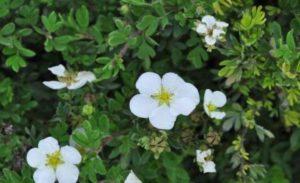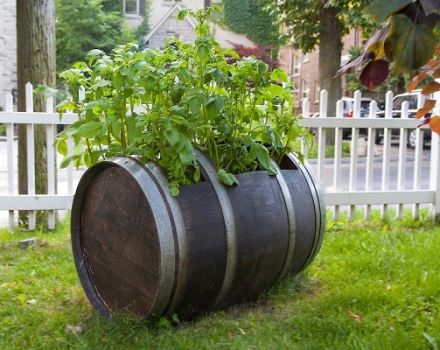Description of magnolia varieties Sulange, methods of planting and care, pruning and preparation for winter
Magnolia is an ancient plant that grew back in the era of the dinosaurs. Magnolia Soulange was bred at the beginning of the 19th century by the French breeder E. Soulange-Bode as a result of crossing of 2 magnolias: lily and nude. It was loved by landscape designers and gardeners for the variety of varieties, early beautiful and abundant flowering.
Botanical description
The height of the Soulange magnolia, depending on the variety, varies from 2 to 8 meters. Grows as a deciduous tree (in the south) or a shrub (in the north). Its branches begin to grow at the very base of the earth, forming a low-set, rounded or pyramidal crown. Light green leaves of the plant are smooth above and pubescent below.
Large (up to 25 centimeters in diameter) goblet or cup-shaped inflorescences are the main decoration of a magnolia. In color, they are white, purple, white-pink, red, and can also be two-colored. They open in April-May, at a time when the foliage of the rest of the trees and shrubs is just beginning to bloom. Inedible fruits ripen at the end of September.
Classification
The magnolia species of Soulange includes more than 2 dozen varieties. Description of the most decorative ones:
- Alba Superba - the plant reaches a height of 3-5 meters. Large green leaves turn yellow in autumn. Delicate white inflorescences bloom in early May before foliage appears. They are similar to tulips, emit a pleasant aroma.
- Alexandrina is a feature of this variety in a spreading crown. Goblet pink-purple large (up to 15 centimeters in diameter) flowers bloom in May at the same time as the leaves.
- Lennei is a slow-growing magnolia bush, reaching a height of 5-6 meters. Inflorescences are large, dark purple outside. In this variety, the branches do not freeze even in severe frosts.
Important! In order not to be disappointed with the result, it is necessary to purchase planting material in nurseries or from trusted sellers..

The subtleties of growing
Many gardeners believe that Soulange's magnolia is tender and capricious, and do not plant it in their plots. But if you choose the right place for her, take care of her in accordance with her requirements, the culture will respond with the flowering of beautiful, fragrant buds.
How to choose a landing site
A properly chosen planting site is one of the main conditions for the growth and development of magnolias. The culture should be planted in an area protected from wind and midday sun rays.The older the magnolia, the less sensitive it is to bright sunlight, but it does not tolerate a transplant, so it must be planted in a permanent place immediately.
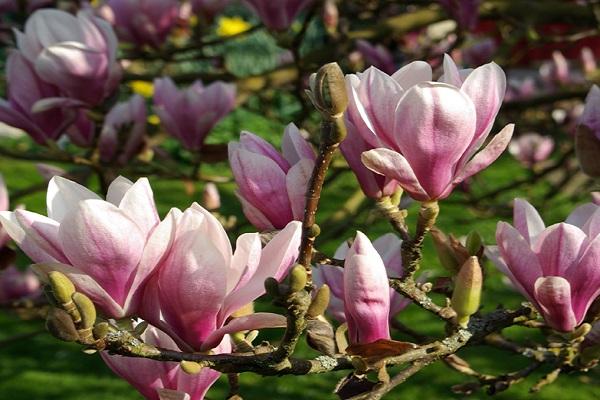
Pit preparation and soil requirements
The soil in which magnolia is planted should be light, loose, neutral or slightly acidic. It is composed of the following components: garden soil, rotted manure, compost, peat, sand, wood ash. Planting a seedling is done as follows:
- a hole is dug with a diameter that is 2 times the size of the root system of the plantation;
- at its bottom, drainage is laid with a layer of 15-20 centimeters, consisting of broken bricks, expanded clay, small stones.
- a layer of sand (up to 15 centimeters) wakes up on top of the drainage, then the prepared substrate;
- a plant is planted in the center of the pit.
The surface of the trunk circle is rammed a little, watered abundantly.
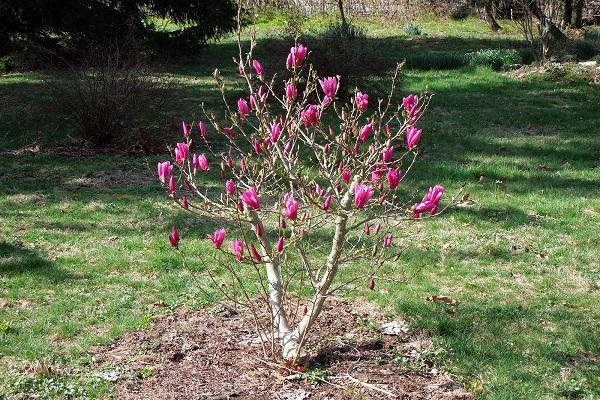
Landing features
Since the roots of the Soulange magnolia are shallow, shallow, the ground around it must be mulched with peat, and then with the bark of coniferous trees. It is better to plant plants in autumn: during this period they are in relative rest, which contributes to their rapid survival and good wintering.
Advice! The seedling in the container is first moistened with water, and then removed and, together with a lump, planted into the ground.
Magnolia Care Tips
Subject to the requirements for caring for the plant, it will delight others with its decorative appearance for a long time and you will not need to take emergency measures to save it.

Watering and feeding
Magnolia Sulange is a moisture-loving planting. Young seedlings 1-3 years old are especially in need of systematic watering. The soil is moistened with warm water, while it is necessary to ensure that it is not constantly wet.
2 years after planting, the plant begins to feed. Nutrition with a complex of mineral fertilizers promotes the development of magnolia, reduces the harmful effects of negative weather factors. The procedure is carried out until the end of July: starting in August, the plant begins to enter a state of dormancy and no additional feeding is required.
Loosening the soil
Magnolia roots are close to the soil surface, so loosen it carefully. The depth of cultivation is 2-3 centimeters. It is better to use a pitchfork for this, as other gardening tools can injure the roots. The resulting weeds are removed manually.
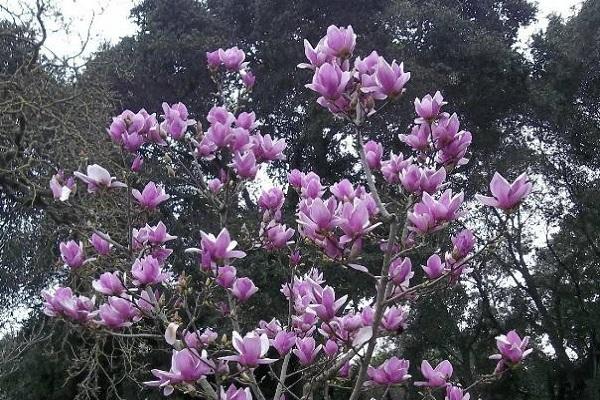
Mulching
To preserve moisture in the soil, to prevent the growth of weeds, and also to less injure the root system, the magnolia root circle is mulched. For this, peat, sawdust, bark of coniferous trees, straw are used. They cover the ground in spring, during the season the mulch is renewed. Its permanent layer is 5 centimeters.
Pruning
Broken, dry, diseased branches are removed in the spring. If young branches are damaged by frost, they are cut to healthy parts. In addition, branches that interfere with the development of each other are cut out: the weaker ones are removed. To prevent harmful microorganisms from getting into the sections, they are treated with garden pitch.
Preparing for the winter period
Autumn care consists in sheltering young seedlings under the age of 3 years for the winter. To do this, after the onset of stable frosts, the soil is covered with a layer of mulch, and the trunk and skeletal branches are wrapped with agrofibre. Small bushes can be completely wrapped in covering material. As soon as a stable thaw sets in in the spring, the shelter is removed.
Additional Information. Winter warming of the air is dangerous for magnolia: buds starting to wake up will be destroyed by the subsequent frost.
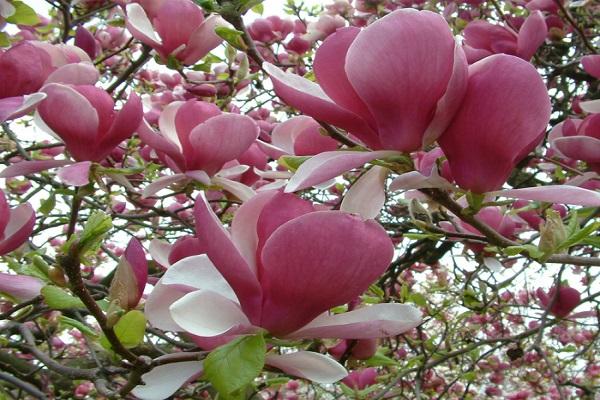
Protection against diseases and pests
Although Soulange's magnolia is rarely exposed to the harmful effects of the environment, some diseases and pests can overcome it:
- Chlorosis. With this disease, the leaves of the plant turn yellow, and the veins remain green. This is due to the excess lime in the soil. To save magnolia from adversity, the soil is acidified with peat, earth taken from under coniferous trees.
- Spider mite. It settles on the leaves, from which it sucks the juices, as a result of which they turn yellow and fall off. To get rid of a harmful insect, magnolia is sprayed with any of the acaricides.
- Rodents. Underground pests gnaw at the roots and stems of the plant at the very base. The affected parts are treated with garden varnish. To protect magnolia from various rodents, it is sheltered only after the onset of frost: in such conditions, pests cannot build nests and damage plantings.
In addition, magnolia soulangeana can be affected by fungal diseases. This is most often due to an excess of moisture. Treatment of the plant with any fungicide will help to get rid of the misfortune. For bacterial spot disease, magnolia is sprayed with copper-containing preparations.
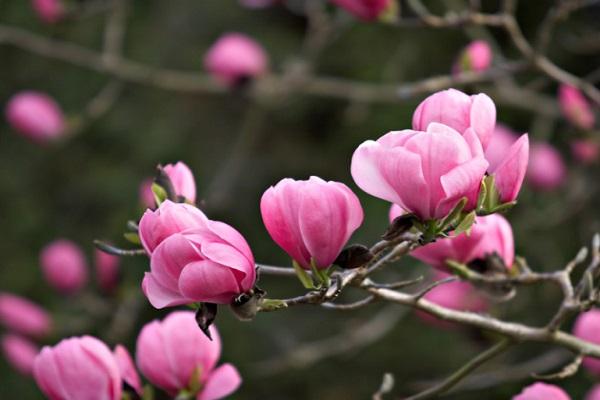
Reproduction methods
Under natural conditions, magnolia propagates by seeds, at home - for this, the vegetative parts of the plant are used, and cuttings are used, cultivation by layering, grafting. The most common way to get a young seedling at home is by cuttings. This requires:
- cut off cuttings of two-year-old shoots in summer;
- dip their lower ends in growth stimulant powder;
- plant in loose, light soil, water;
- cover the pot with cuttings with foil to establish greenhouse conditions under which roots quickly form on them.
Layering is another common way to get a young magnolia bush at home. For this, the lower branches are bent to the ground, pinned, sprinkled with earth. The place where the shoot touches the ground must be constantly moistened. A year later, the rooted stalk is dug up and transplanted to a permanent place in the garden.
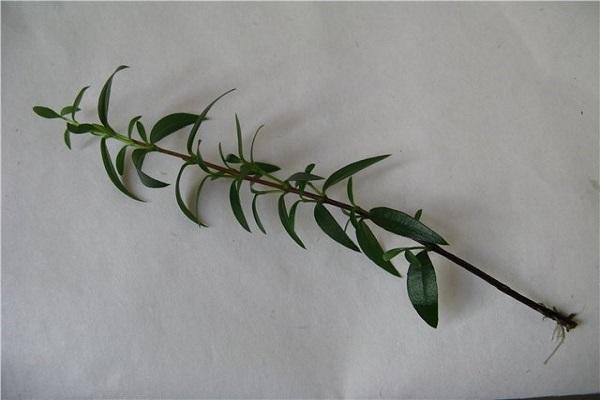
Use in landscape design
Magnolia Sulange is a rather large plantation, so it will look good in single plantings against the background of a lawn. Under the canopy of its crown, shade-loving plants can be placed: hosts, creeping conifers, ferns. In addition, the bushes are grown in tubs, which, if necessary, are moved to the desired place for decoration.
On a note. A plant grown in a pot will tolerate transplanting well in open ground throughout the season.
Growing magnolia Soulange is not difficult, you just need to take into account the superficial location of its roots, as well as the fact that at a young age it does not tolerate the midday sun. Taking care of her during the season, the gardener will be able to admire the beautiful flowering of the plant in early spring, at a time when flower buds are just beginning to form in many plants.
